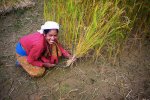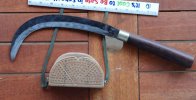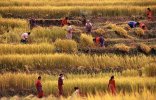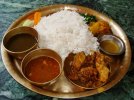The inside of the blade's curve is sharp, so that the user can either draw or swing it against the base of the crop, catching the stems in the curve and slicing them at the same time. The material to be cut may be held in a bunch in the other hand (for example when reaping), held in place by a wooden stick, or left free. When held in a bunch, the sickle action is typically towards the user (left to right for a right-handed user), but when used free the sickle is usually swung the opposite way. Other colloquial/regional names for principally the same tool are: grasshook, swap hook, rip-hook, slash-hook, reaping hook, brishing hook or bagging hook.
The blades of sickle models intended primarily for the cutting of grass are sometimes "cranked", meaning they are off-set downwards from the handle, which makes it easier to keep the blade closer to the ground. Sickles used for reaping do not benefit by this feature because cereals are usually not cut as close to the ground surface. Instead, what distinguishes this latter group is their often (though not always) serrated edges.
A blade which is used regularly to cut the silica-rich stems of cereal crops acquires a characteristic sickle-gloss, or wear pattern.-Wikipedia







